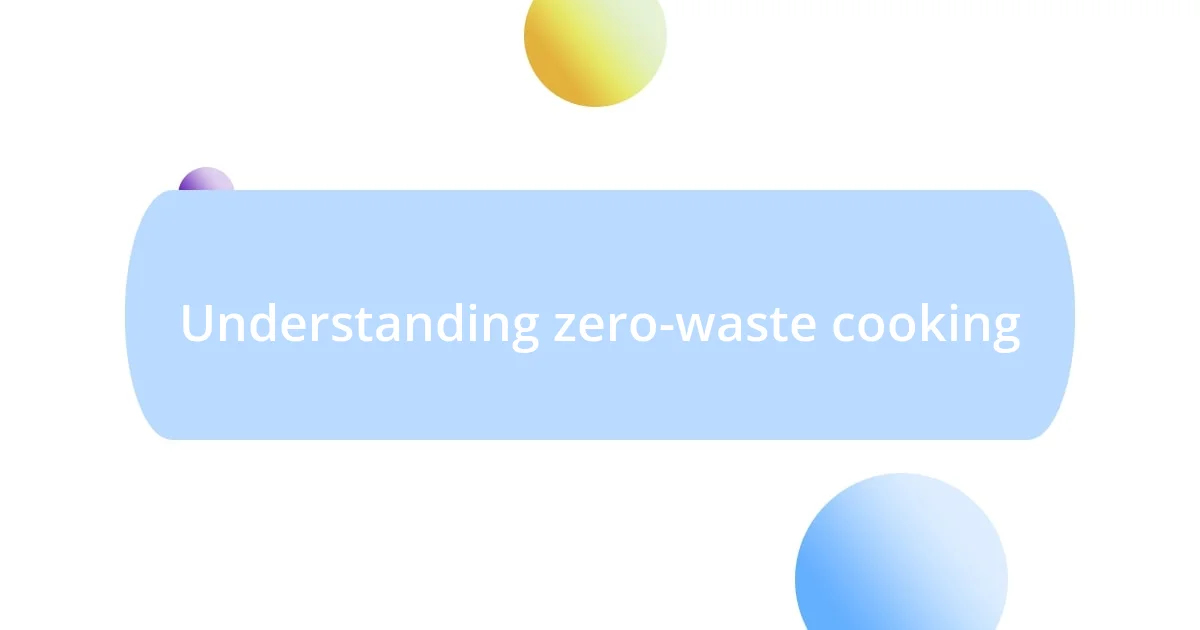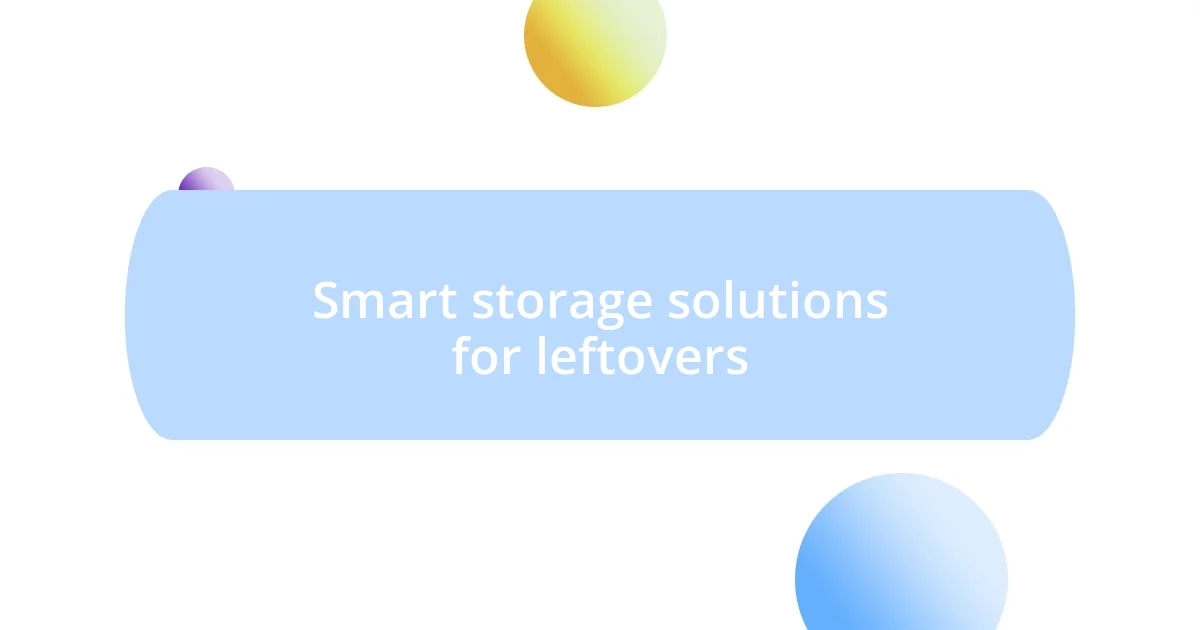Key takeaways:
- Zero-waste cooking emphasizes minimizing food waste by creatively utilizing every part of ingredients, fostering innovation and resourcefulness in meal preparation.
- Meal planning plays a crucial role in reducing waste, saving costs, and encouraging intentional consumption of food, leading to a more fulfilling cooking experience.
- Implementing habits like proper storage, composting scraps, and sustainable grocery shopping enhances food preservation and significantly contributes to a zero-waste lifestyle.

Understanding zero-waste cooking
Zero-waste cooking is all about minimizing food waste and maximizing the use of every part of the ingredients I buy. I remember a time when I made a delicious broth from vegetable scraps—onion peels, carrot tops, and even celery leaves. It felt so rewarding to transform what I usually discarded into something nourishing. Have you ever considered what potential lies in those kitchen scraps?
Embracing this approach also means being creative and resourceful. When I first started, I found myself experimenting with dishes I otherwise wouldn’t have tried. One memorable instance was using stale bread to whip up a savory bread pudding. It dawned on me how much creativity zero-waste cooking encourages—every meal becomes an opportunity to innovate and think outside the box, doesn’t it?
Moreover, zero-waste cooking isn’t just about utilizing food; it involves mindfulness towards our consumption habits. I often reflect on my choices, asking whether I truly need that extra ingredient or if it will end up forgotten. This introspection has connected me more deeply with what I eat and the resources behind it. Have you felt a shift in how you view food and waste since considering the zero-waste philosophy?

Importance of meal planning
Meal planning is crucial in the realm of zero-waste cooking. By taking the time to organize meals in advance, I’ve significantly reduced impulse buying and unnecessary food waste. I remember a week where I carefully mapped out our dinners and made a list before grocery shopping. That week, everything I purchased had a purpose, and it felt wonderful to see the fridge emptied of leftovers rather than overflowing with spoiled produce.
When I truly embraced meal planning, I found several benefits:
- Reduced Waste: Planning helps me use up ingredients before they spoil.
- Cost-Effectiveness: I buy only what I need, avoiding those expensive impulse buys.
- Time Savings: Preparing meals in advance reduces daily cooking time and stress.
- Creative Cooking: It challenges me to think of innovative uses for every ingredient.
I genuinely feel a shift when I sit down at the beginning of the week, jotting down our meals. It’s become a moment where I reflect on what each dish means for my family and the planet. Every little choice makes the whole experience more intentional and fulfilling.

Utilizing food scraps effectively
Utilizing food scraps has truly transformed my kitchen experience. When I first started, I was amazed at how simple vegetable scraps like carrot tops and potato peels could become flavorful garnishes or even a base for soups. One time, I sautéed some beet greens I previously would have tossed into the compost. They turned out to be a delicious and nutritious side dish, and honestly, they added a vibrant color to my plate. Doesn’t it feel great when you can create something delicious from what you normally discard?
Another effective way to utilize food scraps is by making homemade vegetable stock. I’ll never forget the satisfaction I felt the first time I collected my vegetable bits—like onion skins, garlic ends, and herb stems—and turned them into a rich, aromatic broth. By simmering these scraps, I was not just saving money, but also creating a flavor base for future dishes. It’s a game-changer, don’t you think? The next time you chop vegetables, consider how those scraps can boost your culinary adventures!
Lastly, I often find that repurposing scraps can lead to delightful surprises. For instance, after making a batch of guacamole, I decided to plant the leftover avocado pit in my garden. While it took quite a while, seeing the sprout emerge felt like a mini celebration of sustainability. The joy of nurturing something from kitchen waste was beyond rewarding. Have you thought about how small actions like this can contribute to a larger impact on waste reduction?
| Food Scrap | Creative Use |
|---|---|
| Vegetable Peels | Stock or crispy chips |
| Stale Bread | Breadcrumbs or bread pudding |
| Fruit Scraps | Infused water or compost |

Smart storage solutions for leftovers
I’ve discovered that smart storage is a game-changer when it comes to keeping leftovers fresh longer. For instance, I use glass containers with airtight lids. Not only do they look appealing stacked in my fridge, but I also don’t have to worry about any plastic chemicals leaching into my food. Plus, I can easily see what’s inside, making it less likely that I’ll forget about a delicious meal hiding in the back.
One of my favorite hacks is repurposing mason jars for sauces or small portions of leftovers. They’re perfect for portion control, and I love that I can take them on the go when I need a quick lunch. Have you ever tried bringing your homemade soup in a mason jar? It feels great to know I’m not only avoiding waste but also enjoying a meal that’s both nutritious and comforting.
For those who struggle with space, placing a label on each container has been a lifesaver. I remember a time when I’d pull something out and have no idea how long it had been there. Now, I label everything with the date and contents. This small step not only helps me keep track but also encourages me to use leftovers creatively. What can I say? Knowing that I’ve made an effort to waste less puts a smile on my face each time I open the fridge.

Creative recipes for leftover ingredients
When I have leftover rice, my go-to is a hearty fried rice dish. Recently, I combined the remnants of a stir-fry with some cooked quinoa I had stashed, tossing in a bit of soy sauce, leftover veggies, and an egg. It transformed into a wholesome meal that brought the family together around the dinner table. Who knew a simple leftover could spark such a delightful evening?
I also love experimenting with fruit scraps. After making a batch of smoothies, I save the leftover pulp and mix it into my pancake batter. This not only adds fiber but infuses a unique flavor that has everyone asking for seconds. Have you ever tried using leftover fruit pulp like this? The surprised look on my kids’ faces when they devour those pancakes is priceless!
And let’s not forget about those half-used herbs. I once blended leftover parsley and cilantro with some olive oil and lemon juice to create a vibrant chimichurri sauce. It was perfect over grilled chicken and made me feel quite the culinary artist. Finding creative ways to transform ingredients is like a treasure hunt in my kitchen. What leftovers could you turn into a masterpiece?

Tips for sustainable grocery shopping
One of the best tips I’ve picked up for sustainable grocery shopping is to always create a shopping list before heading out. I’ve found that when I don’t plan, I end up buying unnecessary items, which often leads to waste. I’ll jot down recipes I want to try for the week, ensuring that everything I buy will be used. Have you ever experienced the frustration of tossing out food because it went unused? It’s disheartening!
I also love visiting local farmers’ markets whenever I can. There’s something special about connecting with the people who grow my food. Not to mention, I get to choose fresh, seasonal produce that often comes with less packaging than what you find at the supermarket. Supporting local farmers feels like a small yet impactful way to contribute to sustainability. Plus, I get to ask them questions about their growing practices, which I find genuinely enriching.
Another habit that has transformed my shopping experience is bringing my own reusable bags and containers. The first time I did this, I felt a little self-conscious. But now, I see it as a badge of honor. Whenever I bring my jars for bulk items like grains or nuts, I feel like I’m taking a stand against single-use plastic. Isn’t it fulfilling to know that small changes in our shopping habits can lead to a significant impact on the environment? That sense of empowerment is worth every effort!

Building a zero-waste kitchen routine
Building a zero-waste kitchen routine starts with simple yet powerful habits. One practice that has worked wonders for me is designating a specific spot for food scraps. Whenever I peel vegetables or cut fruits, I toss those scraps into a compost bin instead of the trash. Not only does this reduce waste, but it also gives me the joy of nourishing my garden. Have you ever watched your compost transform into rich soil? It’s like magic!
Another crucial step is meal prep, which has really changed the game for my kitchen approach. I often take a couple of hours on the weekend to prepare meals for the week ahead. This process has helped me use every ingredient smartly, ensuring nothing goes to waste. The smell of my kitchen filled with roasted veggies while batch-cooking grains is a comforting reminder of how much I can achieve with just a little foresight. How satisfying is it to see a fridge stocked with healthy, ready-to-eat meals?
Lastly, I made it a rule to shop with a clear purpose. I’ve trained myself to only buy what I need for my planned meals, which saves money and reduces the likelihood of food going bad in the back of my fridge. I remember a time when I came home with a bunch of kale, thinking I’d find a use for it, only to watch it wilt away. Now, I carry a reusable shopping list and focus on what fits into my cooking plans. Doesn’t it feel rewarding to walk out of the store knowing you’ve made mindful choices? These little habits can profoundly impact our relationship with food and waste.














